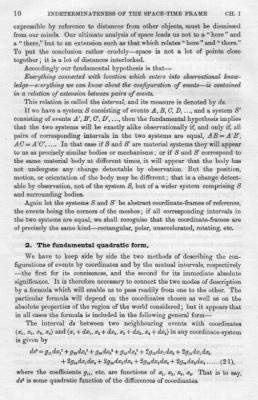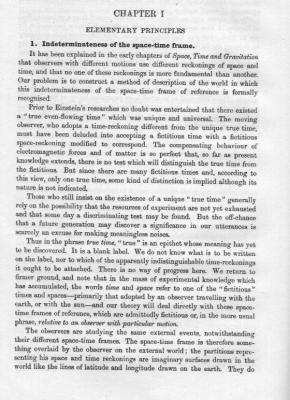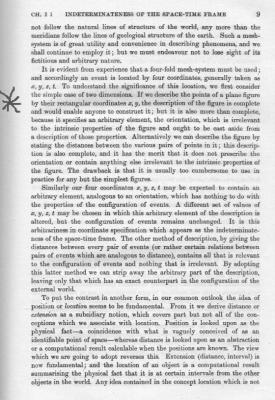-
Posts
18481 -
Joined
-
Last visited
-
Days Won
108
Content Type
Profiles
Forums
Events
Everything posted by studiot
-

How does a body "know" how to move??!!
studiot replied to Rasher Null's topic in Modern and Theoretical Physics
So it does depend on direction as well as speed. One can indeed. But there are many possibilities of formulae for this. Unfortunately not many treatments of relativity discuss why we use the quadratic we do other than to say 'it fits nature' (ie our observations). -
I think you have identified the nub of the issue. +1 What do you mean by the object? An object, say the Earth, has definite extents in the three purely spatial dimensions. Yet you want to set up a (4D) coordinate system whereby simultaneously (in the mathematical sense not temporal) the axes are regarded as equivalent and yet somehow the properties are different for the spatial and time derived ones. If we identify extents in space why not in time or (ict) ?
-

How does a body "know" how to move??!!
studiot replied to Rasher Null's topic in Modern and Theoretical Physics
So what would be the contraction at 45o to the direction of motion? -
Have we done sniping now? I am more concerned with the lack of OP response to my post#23
-

How does a body "know" how to move??!!
studiot replied to Rasher Null's topic in Modern and Theoretical Physics
What would be the contraction at right angles to its direction of motion? -
First you need to be clear about the difference between Steady flow Uniform flow Laminar Flow Turbulent flow Vortex flow Rotational flow Irrotational flow. Brownian motion The main difference between laminar and turbulent flow is that the transport or transfer coefficients for laminar flow are molecular coefficients and are properties of the fluid, whereas for turbulent flow they are known as eddy coefficients and are properties if the flow. Flow is never fully laminar or fully turbulent, the total transport properties are the sums of the molecular and eddy coefficients and the ratio of these coefficients determine whether we call the flow turbulent or laminar.
-
I am not an astrophysicist, perhaps one here will answer authoritatively. Meanwhile look up sublimation of ice, which I believe is the process you seek. https://en.wikipedia.org/wiki/Sublimation_(phase_transition)
-
Considering the definition of boiling point The temperature at which the vapour pressure of the liquid is equal to the pressure of the gas above it the question has no meaning in a vacuum.
-

How to calculate CO2 absorbtion by my Garden
studiot replied to studiot's topic in Ecology and the Environment
Thanks, Sensei for the suggestions. Ever the practical man I see. I fear that would be rather inaccurate, however. Don't forget that plants produce often at least as much material below ground as above. I would also need to add in the weights of heavy crops such as potatoes and apples. Grass, too, though not weighty is cut many times a year. I was really hopong that someone from the life sciences would respond with some average figures I could plug in. -

How does a body "know" how to move??!!
studiot replied to Rasher Null's topic in Modern and Theoretical Physics
If your interest is genuine, why do you not answer comments directly affecting your original post and keep introducing extraneous material? Both of these practices are against forum rules. The question What is motion ? is a much better question than your original one. -
I was wondering how much CO2 my garden removes from the atmosphere and how to develop a calculator for this purpose for other gardens. First thoughts are to do it by ground area and to separate the ground area into zones of different plant size (height) thus: Zone 1 - Grass and low plants less than 0.5 m high Zone 2 - Plants 0.5 to 3.0 m high eg shrub borders , hedges tall vegetables etc Zone 3 - Small trees and other plants 3m to 6m high Zone 4 - Trees taller than 6m high I would welcome comments on whether these are sensible divisions and any steers on how to obtain average CO2 reductions for them.
-
I remember they had this programme when I was there http://www.lboro.ac.uk/departments/chemistry/pg-taught/
-
Perhaps now would be a good time to start? We'd all like to help you know.
-

How does a body "know" how to move??!!
studiot replied to Rasher Null's topic in Modern and Theoretical Physics
Yes it is one route to general relativity. https://en.wikipedia.org/wiki/Einstein%E2%80%93Hilbert_action -

How does a body "know" how to move??!!
studiot replied to Rasher Null's topic in Modern and Theoretical Physics
Was that before or after you became a novice at theoretical physics? A good example of 'the troll theorem', if you ask me. -
Similarities indeed. But what about the relativistic triangle inequality for time and distance?
-

How does a body "know" how to move??!!
studiot replied to Rasher Null's topic in Modern and Theoretical Physics
Really, Strange, why waste a good troll? -
I have to say that both ajb and I and perhaps also others took this to mean that you wanted to study mathematical chemistry in a formal course. Do you really mean that you simply want to apply your maths to help your flatmates in some way, as a private project? Hypervalent iodine is right to say that you need some knowledge of chemistry to do this effectively. Note the word apply, Chemists' use of mathematics is applied. I can't imagine your flatmates being interested in the pure mathematics supporting the applications. Further many of the applications spring from the border area between Chemistry and Physics So much so that on of the leading textbooks of the last century was entitled The Mathematics of Physics and Chemistry By Margenau and Murphy. Most of the group theory developed there is for crystal chemistry. Also look at the more modern The Chemistry Maths Book : Steiner I previously mentioned reaction kinetics. Some of this is at the forefront of applied maths and includes (systems of) differential equations not all of which have known solutions and many of which are non linear in character. The emphasis placed on the basic principles that underpin both Physics and Chemistry is different, no more so than in Quantum Mechanics. Physicists tend to concentrate on primary particles - atoms and below. Chemists are more interested in combinations of atoms, called molecules. So a look at high level quantum chemistry takes on quite a different view from high level quantum physics, although the same underlying science is still there. Contemporary Quantum Chemistry : Goodisman Molecular Quantum Mechanics : Atkins and Friedman QM is also bound up with another mathematical area common to maths and physics, spectroscopy. Spectroscopy : Whiffen. Apart from the above books, another area of rapid modern development is the mathematics of electrochemistry Modern Electrochemistry : Bockris and Reddy
-

How does a body "know" how to move??!!
studiot replied to Rasher Null's topic in Modern and Theoretical Physics
Exactly. +1 Rasher Null I gave you a specific answer to your specific question and amplified it with a practical example from real life. The only answer from you was to accuse me of being dismissive. -
Sensei +1 since the OP didn't
-

How does a body "know" how to move??!!
studiot replied to Rasher Null's topic in Modern and Theoretical Physics
I'm sorry, what does coding have to do with my tank of water? -
Ask your friends to explain chemical kinetics (rates of reactions) to you. Particularly in respect of catalysis and surface chemistry.




